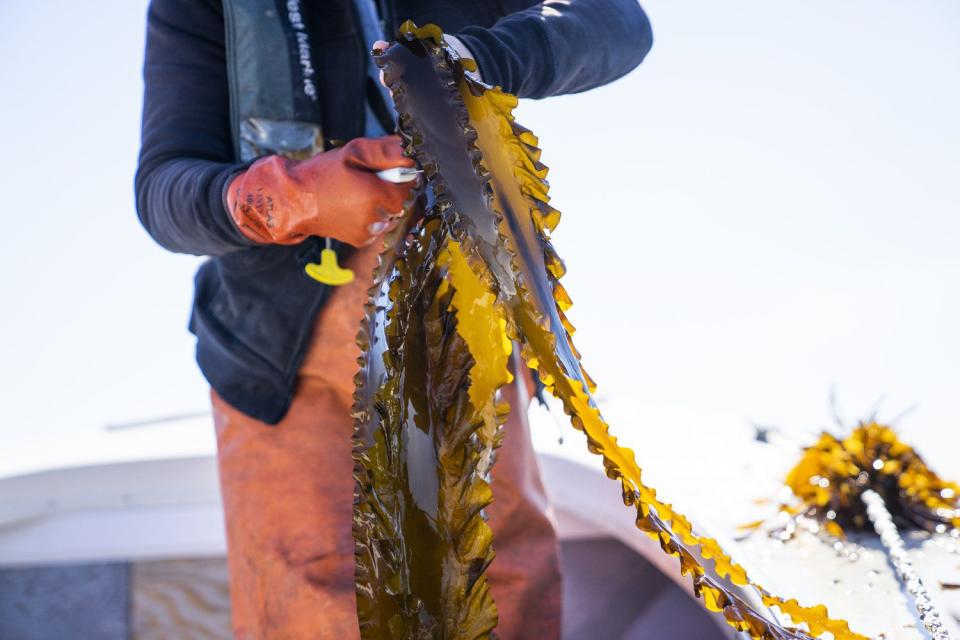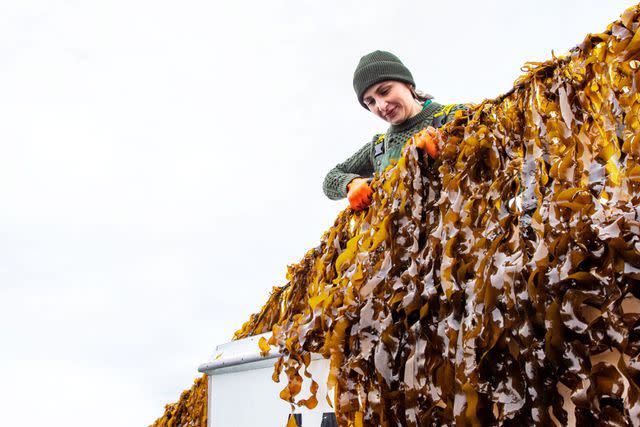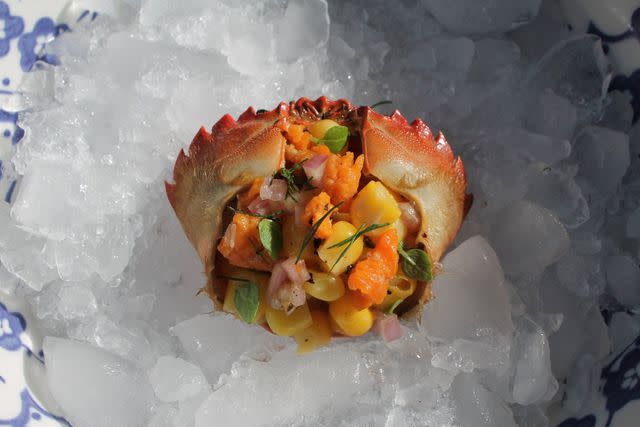Where to Taste New England's Wave of Eco-Friendly Seafood
Taste how the seafood industry is changing in response to climate change and invasive species.

Stonington Kelp Company
Lobster rolls and fried shrimp are longstanding favorites in New England for good reason — they’re delicious uses for local ingredients. But as the climate changes, fish stocks relocate or dwindle, and classics like Maine shrimp become off-limits, a wave of innovators is popularizing two important additions to restaurant menus and grocery store shelves: seaweed and green crab.
Seaweed farming
Seaweed is a miraculous thing: It only needs seawater and sunlight to produce an impressive amount of nutrients and flavor, all the while sequestering excess carbon and nitrogen from the ocean. Harvested in the spring, its season complements that of lobster, so it adds a revenue stream and resilience for fishing communities. And since it gets seeded on ropes, it’s not going to scuttle north to Canada as waters warm. Americans have been slow to develop a mutually beneficial relationship with edible seaweeds, but the commercial market is growing by leaps and bounds thanks to the creative efforts of some New England stars.
Stonington Kelp Company has led several seaweed initiatives in Connecticut and Rhode Island, including co-founding the Sugar Kelp Cooperative and Kelp Week — now more like Kelp Month as more restaurants serve kelp dishes, offer cooking classes, and host special dinners during harvest throughout April and May. When Food & Wine spoke with co-owner Suzie Flores a few years ago, she had “become a tour guide by default” in her efforts to drum up demand. “Sugar Kelp is amazing to cook with, but there is a pretty steep learning curve for most people,” says Flores. However, when she brought chefs to her farm and explained the story of kelp, its environmental benefits, its versatility, and let them try it right from the ocean, Flores said she had customers for life.
Now, she's become a tour guide more officially, inviting everyone to experience by boat her southeast Connecticut farm. You can have your own epiphany while admiring the sights of Block Island Sound and hauling in some kelp — plus recipes so you know what to do with it at home. This type of aquatic agritourism is gaining steam; farther east, you can also tour Chatham Kelp’s farm on Cape Cod, Massachusetts.

Atlantic Sea Farms
Like many seaweed companies selling their harvest in myriad forms, Chatham partners with Atlantic Soap Company on a kelp beauty bar, while Stonington makes kelp-based spice blends like furikake. This extends the fresh ingredient’s relatively short shelf life and softens the learning curve for using it. Atlantic Sea Farms, whose model of providing kelp seeds and buying the results minimizes financial risk for fishermen, continues to develop unique kelp products at its headquarters in Biddeford, Maine. “We aim to make our products not only delicious but also easy to use and accessible” so they require little to no preparation, says CEO Briana Warner. As a bonus, some preservation methods can even increase kelp’s already powerful health benefits, as in the case of Sea-Chi, a kelp-based kimchi, and the company’s biggest hit, Fermented Seaweed Salad. The fermentation of these products “promotes gut health while also naturally preserving the freshness of the sea greens,” Warner says.
You can find these Atlantic Sea Farms products and others — like kelp smoothie cubes and the latest winning formula, Sea-Veggie Burgers in flavors like basil pesto — at Whole Foods across the country. The kelp patties also offer an enticing vegan option at forward-thinking restaurants such as SoPo Seafood, a fishmonger and raw bar in the buzzy Knightville neighborhood of South Portland, Maine, and Luke’s Lobster in Portland, Maine’s Old Port.
Getting into green crab
Since humans brought the European green crab to the U.S. over a century ago, the small crustacean has become highly invasive. Left unchecked, the green crab devastates the native eelgrass habitat and shellfish populations. One of the most promising ways to mitigate the harmful impact on native species is to harvest and eat the green crab, says Mary Parks, founder and executive director of Green Crab Org. That’s why her nonprofit spreads awareness and builds markets for the tenacious interloper throwing off the balance of our ecosystem. “Plus, with overfishing and climate change we are losing access to so many species, so we might as well enjoy a seafood we can eat indefinitely,” she says.
Parks founded Green Crab Org, which has a robust selection of free recipes, in 2020. The year before, she wrote and edited The Green Crab Cookbook with Thanh Thái, a New Hampshire-based nurse whose blog, Green Crab Cafe, is also full of free recipes. The duo drew inspiration from all over the world, including Venice — where the soft-shell native green crab is called moeche and eaten with gusto — and Southeast Asia, since green crabs and rice paddy crabs are a similar size and flavor. Unlike large Dungeness or blue crabs, green crab meat is tricky to pick, so Parks and Thái recommend starting with a simple stock, oil, or shucking roe in the fall and spring. Parks especially loves to use the stock in Caldeirada de Caranguejo, a Portugese green crab stew, and the roe in a corn salad served in the shell.

GreenCrab.org
Green crab isn’t common at fish markets yet, so Green Crab Org’s database of green crab suppliers will help you find what you need for these recipes. Parks says for many people, the best bet will be Wulf’s Fish, a Boston fishmonger whose online store ships 3-pound packs of frozen green crabs anywhere in the U.S. Green Crab Org’s homepage also has a list of restaurants currently serving green crab, such as Viale, which offers a green crab and pumpkin soup in Cambridge, Massachusetts, and Providence, Rhode Island’s Oberlin, whose heirloom corn fusilli with green crab butter was one of the most memorable dishes Parks ate last year.
Green crab also graces the menu at some of the top restaurants in the famous seaside town of Mystic, Connecticut, alongside other thoughtfully prepared local seafood and seaweed. Chef Renee Toupance takes fish processing to bold new places for Oyster Club and The Port of Call. “The area from Mystic to the Cape represents the oldest commercial fishery in the U.S., and we have an obligation to protect and preserve,” she says. “Part of eating sustainably is knowing how to use everything and waste nothing.” Green crab gets smashed, roasted, and turned into stock; bluefin tuna tail dried for 12 weeks yields a funky ham; swordfish, monkfish, and fluke scraps become beautiful chorizo verde.
Similarly, at The Shipwright’s Daughter, chef David Standridge only serves local and wild fish. He makes a gorgeous green crab vinegar to jazz up sustainable mild, white fish like scup, as well as an XO sauce from fish trimmings, and he’s trying to convince more diners to be comfortable with fish bones, the way they would be with a chicken bone. “Chefs play a powerful and unique role in how our food system works,” he says. “We can have an outsized influence on both suppliers and consumers,” simultaneously pressuring suppliers to work with responsible fishermen and educating diners who become champions for undervalued species.
Drink to the success of the mission with a bottle of Crab Trapper, a bourbon infused with real green crab, corn, and savory spices to evoke a low country boil. It could only come from New Hampshire’s Tamworth Distilling, whose founder, Steven Grasse, was one of Food & Wine’s Drinks Innovators of the Year in 2023 for his off-the-wall spirits creations. Serve shots of Crab Trapper like an East Coast Malört to unsuspecting dinner guests, mix it in savory drinks like Bloody Marys and Green Crab Caesars, or try it as a flavor boost for bisque, as fisherman John Painter has done in the course of research for his nascent business, Maine Green Crabs.
Painter is developing his green crab harvesting operation and a soup stock with crabs freeze-dried by another Maine entrepreneur, Green Gean’s. St. Ours of Weymouth, Massachusetts, is also working on green crab broth. Yet another upcoming business, Maine Garum Company, has been testing green crab garum, the Roman fermented fish sauce that ensures no scraps get wasted, and Painter recently made a beautiful batch of fried rice with it. That spirit of adventure and collaboration is key to the sustainability of New England seafood. “We want to share the story of the fisherman, the oyster farmer or kelp farmer, the story of why their efforts matter,” says Mystic chef Touponce, “and the story of why we as a restaurant and you as a consumer have a responsibility to positively impact this story.”
For more Food & Wine news, make sure to sign up for our newsletter!
Read the original article on Food & Wine.

